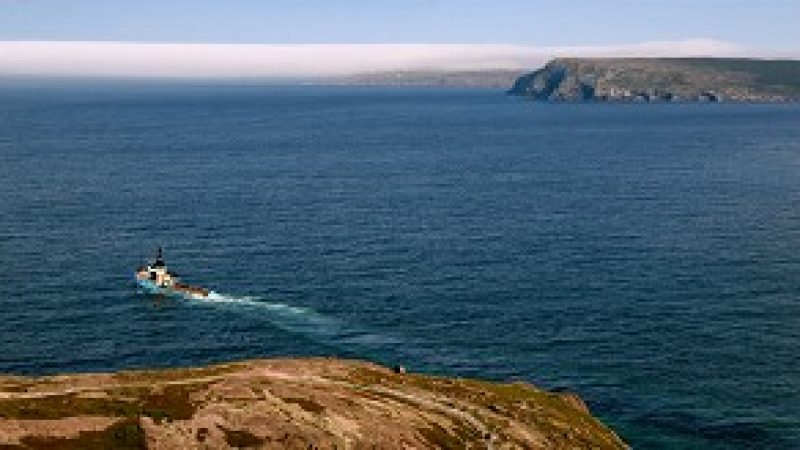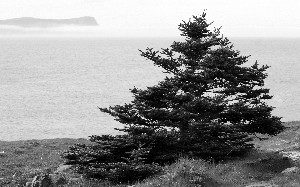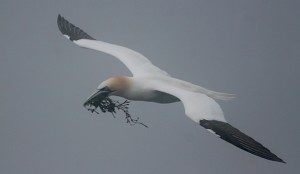
From Coast to Coast in Newfoundland (Part 1)

Ah, Newfoundland. Whenever I think of its craggy shores, or its disarmingly hospitable people, a strange sense of longing builds in my mind. I was pondering this nostalgia last June, when I found myself once again sitting on a pebbly salt-water beach in Norris Point, deep inside Newfoundland’s Gros Morne National Park. The flat-topped deep-orange mountains called the Tablelands looming before us, I turned to my wife, and in her eyes I saw new understanding of why exactly it was that I kept reminiscing about this place. It’s not everywhere that the earth’s mantle emerges out from deep within its crust, in this case earning the site UNESCO World Heritage designation.
Years ago I worked in the Newfoundland wetlands, on the other side of these mountains, studying old-growth forest dragonflies. Though I didn’t spend much time right by the ocean, I did get to know the bogs, the mountains, the rocky barrens, the moose and caribou, the rolling fog, and the tuckamore. The experience changed me. I started to yearn for this land, and became acutely aware of the magic that keeps Newfoundlanders, wherever the may have settled, returning to their isolated home.
Last June, it was time to go back, this time with family. The stage was set: A happy thirty-something couple, with our doting mothers. Return air tickets to St. John’s, and a rental car waiting at the airport. Exactly five days extracted from our busy schedules.
 FAR EAST: A stunted black spruce faces the ocean in the barrens at Cape Spear, Newfoundland, the easternmost point in North America. (Jan Jekielek/The Epoch Times)
FAR EAST: A stunted black spruce faces the ocean in the barrens at Cape Spear, Newfoundland, the easternmost point in North America. (Jan Jekielek/The Epoch Times)Around St. John’s
With no time to waste, upon landing we loaded up our roomy Pontiac and headed south to Bay Bulls, staging area for renowned whale-watching trips and home to some of Newfoundland’s largest puffin colonies. The sky was sunny as we left St. John’s, but as we approached Bay Bulls, the fog came in something heavy. We opted to sit down to some hearty clam chowder and fish & chips, at the best restaurant in town, Sailor’s Galley.
There’s a saying in Newfoundland: If you don’t like the weather, just wait a minute – and it’s true in spades. Soon after dinner the weather turned around again, but by this time the last tour of the day had gone.
The remainder of the afternoon took us back north, high into the mountains overlooking the St. John’s harbour, and out to Cape Spear, the most easterly point in North America. The ocean views overlooking rugged vegetation speckled amidst barren rock were nothing short of stunning, as was watching, once again, the fog rolling in. Within ten minutes or so, revolving swirls of mist managed to turn the bright sunny scene into an ethereal, barren land of quiet.
Soon afterwards, we made our way to the nearby Signal Hill, where the first wireless trans-atlantic message was received in 1901. There, the sun ruling the fog again, we were treated to magnificent views of the open ocean, as well as of St. John’s harbour and the city itself.
 BONNE ESPERANCE: The beautiful flower garden behind the Bonne Esperance House Heritage Inn, located on the famous Gower Street in St. John’s, Newfoundland. (Jan Jekielek/The Epoch Times)
BONNE ESPERANCE: The beautiful flower garden behind the Bonne Esperance House Heritage Inn, located on the famous Gower Street in St. John’s, Newfoundland. (Jan Jekielek/The Epoch Times)Demanding nothing less than the best accommodations „because we deserve it,“ our mothers opted to stay at the four-star Bonne Esperance House Heritage Inn on St. John’s famous Gower Street, a genuine Heritage Site itself. This is where our moms were introduced to the real heart of Newfoundland, its people, the aspect that turns the quality of one’s stay on the Rock from „great“ into „exquisite.“
The innkeeper, Regina, had left Newfoundland in her teens to seek her fortune, and ended up in the high-end service industry—she once organized a 1000-person dinner hosted by none other than Queen Elizabeth II herself.
Indeed, as is her namesake, Regina treated us like royalty. Each room at this Victorian inn was highly original, with period furniture and wall hangings, and the delicious gourmet pancake breakfast the following morning kept us in our seats an hour longer than we expected.
Behind the inn, Regina planted a magnificent multi-coloured garden, quite unlike anything I’d ever seen on the Rock—making us forget, for a moment, where we were. The foghorns quickly brought us back, confused yet grateful in the realization.
 BUILDING: A Northern Gannet approaches Bird Rock, a giant sea stack at Cape St. Mary’s Ecological Reserve, Newfoundland, where 20,000 of its kind nest in the breeding season. It carries in its beak nesting material. (Jan Jekielek/The Epoch Times)
BUILDING: A Northern Gannet approaches Bird Rock, a giant sea stack at Cape St. Mary’s Ecological Reserve, Newfoundland, where 20,000 of its kind nest in the breeding season. It carries in its beak nesting material. (Jan Jekielek/The Epoch Times)The Cape Shore
Day Two: We left St. John’s to the south-east, following highways 90 and 92, on what is known as the Cape Shore route. Our destination: Cape St. Mary’s Ecological Reserve, home to one of the largest and easily reached seabird colonies in the world.
Two-hundred kilometres of rock and black-spruce forest later, we landed on the Cape. The fog, again in its eerie silence, was covering us so thickly that we couldn’t see a thing, save a boardwalk leading from the parking lot, disappearing into nothingness. Following it, 20 metres later we were inside the visitor centre.
And here once again we were met by the Newfoundland magic, it’s populace. Biologist and Reserve interpreter Chris Mooney excitedly gave us the run down. We learned that literally tens of thousands of birds, mostly Northern Gannets, could be found living on a large sea stack, dubbed Bird Rock, not one kilometre away.
„Don’t worry about the fog, you’ll see many birds out there,“ he said with a trademark Newfoundland accent. „But whatever you do, don’t leave the trail.“
The trail, we soon learned by ‚trail and error‘, runs very close to a cliff face over open ocean. Every so often, a sheep or some newborn lambs would materialize out of the fog, only to disappear a few moments later. As we moved towards our goal, we began to hear what sounded at first like a dinner party in the distance. As we got closer, the din grew in cacophonic volume, until suddenly and almost without warning, we came upon Bird Rock and about 20,000 of its inhabitants.
The sight of 20,000 Gannets squawking side by side on a giant sea-stack, not ten metres away from you across a deep precipice, is something I will leave you to imagine—and hopefully someday see for yourself. It was a sight to behold.
Next week: Puffins in Bonavista, the towering cliffs of Westernbrook Pond, a perfect Seaside dinner, and capricious Twillingate Minke Whales.
(The Epoch Times)




























vielen Dank, dass Sie unseren Kommentar-Bereich nutzen.
Bitte verzichten Sie auf Unterstellungen, Schimpfworte, aggressive Formulierungen und Werbe-Links. Solche Kommentare werden wir nicht veröffentlichen. Dies umfasst ebenso abschweifende Kommentare, die keinen konkreten Bezug zum jeweiligen Artikel haben. Viele Kommentare waren bisher schon anregend und auf die Themen bezogen. Wir bitten Sie um eine Qualität, die den Artikeln entspricht, so haben wir alle etwas davon.
Da wir die Verantwortung für jeden veröffentlichten Kommentar tragen, geben wir Kommentare erst nach einer Prüfung frei. Je nach Aufkommen kann es deswegen zu zeitlichen Verzögerungen kommen.
Ihre Epoch Times - Redaktion